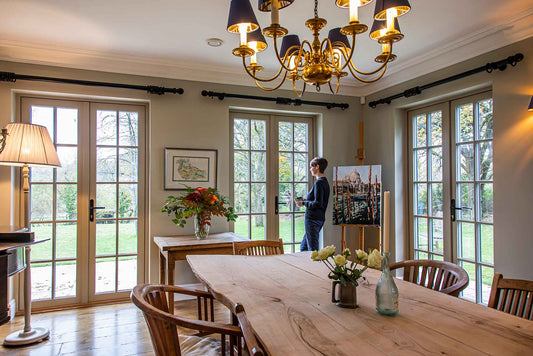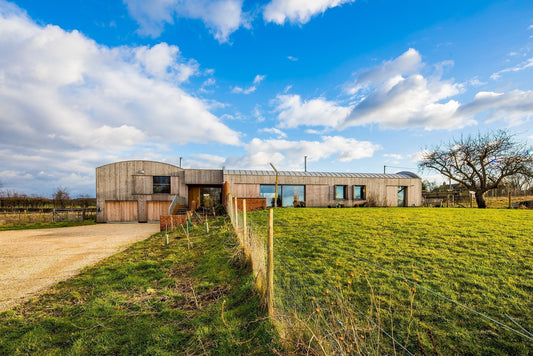Award-Winning retrofit: Ravine House
Excellence in design, construction & glazing
A Norrsken case study
Generally speaking, housebuilders and homeowners seeking superior levels of energy efficiency tend to build from scratch, rather than retrofitting existing properties. And it seems sensible - having complete control from the foundations up should facilitate the most efficient build possible. 'Money pit' refurbishments and nightmare home improvement projects are all too common, going over budget and under-delivering on expectations.
Howard Evans, of Chiles Evans + Care Architects, wants to challenge that approach. Collaborating closely with Terry Huggett Developments and using Norrsken windows in this multi-award-winning three-year refurbishment project in the Midlands, the team remodelled the home's performance while retaining the original beauty of the house.
Norrsken discusses the project's challenges, successes, and the mission of sustainable building for the future with Howard.

The striking living room of the Ravine house, featuring Norrsken S315A lift-slide doors with clear lacquer finish internally. Neutral timber frames allow accent furniture to take centre stage.
Howard, it's great to talk about the Ravine house – it's such a striking project. What was the inspiration, and how much client input was there on the design? Have you worked on similar projects before?
It's definitely a different project to any we've tackled before – throughout, we always had the architectural legacy of the original property in mind. The resulting project was heavily influenced; dictated even, by the existing building.
The first house was built in 1967 to a very high standard - everything we found over the build was beautifully executed.
Cutting-edge double-glazing (only introduced to the UK two years previously) made it one of the first properties to feature double-glazed windows in the country. The client even possessed correspondence discussing the installation of heating under the driveway!
Despite some impressive features, though, the house lacked both central heating and proper insulation. This made it an energy-hungry building - unsurprising for the abundance of cheap energy available during the 1960s, but from the 1970s onwards when prices rose and oil supply plummeted, it simply remained cold and expensive.
The client's initial request was "knock it down and rebuild it – but warmer".
The approach that we actually settled on was rather different. The objective shifted to preserving the style of the original building and restoring it to a very high standard, rather than rebuilding from scratch.
To achieve that, we asked some extreme questions.
Could we take it off-grid?
Could we completely remove the need for gas?
A borehole now supplies both drinking water and heating via a ground source heat pump. We specified photovoltaics on the roof, insulated the entire house, improved airtightness, and had the best triple-glazed composite windows installed.
How did you plan to blend the remodel with the rest of the house? The surrounding environment?
Our ethos here was to look, research, and consider our options. We focused on getting the best of everything rather than tearing down and rebuilding. The design was kept very much in line with the mid-century American feel of the existing home, and as much as possible was preserved and reclaimed or recycled on-site.
The palette stayed as close to the original choices of brick, timber, stone, and copper as possible. The alu-clad window frames are a muted RAL 7021 black-grey externally and mostly a warm wooden finish internally. Details were kept as close to the original as was achievable - research included tracking down 1966 Danish door handles, original light fittings, and even a wall-mounted sink originally designed for the Barbican Centre in London. Many things were custom made or specially sourced to fit the client brief.
New elements, like the brand new conversation pit in the extension, were clad in striking copper to integrate them seamlessly with the rest of the building.


What were the biggest challenges?
The Covid-19 pandemic caused real disruption to an already complex project. Slowing down and staggering the trades on-site was logistically challenging at times - something I'm sure site managers across the country can sympathise with.
Strict emphasis on preservation of the original property while completely overhauling its performance also created challenges. For example, the copper-clad exterior of the roof removed the possibility of insulating it from the outside – but internally, the angled timber ceiling structure had to be preserved – and somehow between the two, we had to insulate the roof.

Challenges: The impressive original timber roof had to be preserved while insulating the whole building.
We eventually overcame the issue by renewing the copper cladding. We constructed a scaffold tent over the entire building to protect the special timber ceiling whilst we stripped, insulated, and replaced the external roof coverings.

The stunning exterior of the new fire pit entertaining area blends perfectly with the rest of the house.
What were you most excited about?
As both an architect and a university lecturer, I think it's really important to challenge the belief that we should always knock down and rebuild. That's not to say that I don't emphasise the difficulties of building a low-energy retrofit – case studies like this are perfect for teaching the next generation of architects and designers exactly that. But, when we work with houses as unique as this, we can really test our approach to retrofit.
A growing proportion of new homeowners and housebuilders are becoming aware of the energy efficiency of their homes and that newly built structures can be significantly inferior to buildings retrofitted with real care. Close attention must be paid to the 'fabric first' approach - that is, maximising the performance of components and materials that make up the building fabric itself before turning attention to energy-saving after-products. By keeping this mentality at the forefront of our design brief, we were able to strike the balance between conservation and a real performance overhaul.
How do you decide who to collaborate with?
Real teamwork has been vital across the board to get all the details correct and achieve the desired level of efficiency.
You must have confidence that the contractors and subcontractors onsite will work to the same standards you expect of your own work. For example - the windows in the original build, imports from Scandinavia, delayed the project by several months. Norrsken's involvement was obviously much more timely! We knew we needed to specify high-performance windows and doors, and engage a company who can operate in the low-energy and Passive House market. So, having worked with Norrsken and THD before, the choice was an obvious one.
A project like this is very much a collaborative journey – from the client through each party, there has to be a collective focus to get the best possible result and capture the detail of the project, down to the nth degree.

Natural light floods the living spaces throughout the home thanks to its high-performance windows and doors.
Why specify triple-glazed composite alu-clad windows?
The original windows, double-glazed Scandinavian imports, were high-performance for the era. To get the best out of the building, we specified the highest-performing glazing available today.
Norrsken's timber alu-clad hybrids are some of the best on the market, and we knew that the Norrsken team's work would be of a very high standard end-to-end.
Large glass panels appear throughout the design to maximise the light and views of the gorgeous surroundings. If they are not triple-glazed, that much glass risks creating huge temperature fluctuations depending on the season. We needed bespoke products, and triple-glazing is a fundamental part of this temperature regulation – limiting excess warmth in summer, as well as retaining it in winter. Opting for triple-glazed composite windows ensures no cold spots, limits solar gain, and helps prevent conservatory-style heat traps. For those aiming for Passive or EnerPHit performance, triple-glazing is imperative.
Happily, the notion that triple-glazing is a huge step up in cost is gradually being corrected (Norrsken triple-glazed systems generally cost only 10-15% more than double-glazed, while performing between 40-45% better on average). However, it's important to use triple-glazing in the right environments. If the house is poorly constructed and barely airtight, installing triple-glazing is probably not the right move and won't work as well as in a very airtight building.

The high-performing P31A window was used throughout the project. Triple-glazing is a key criterion in achieving Passive and EnerPHit certification.

Natural timber finishes on the windows and S315A lift-slide doors allow the clients real freedom to experiment with colour, texture, and design in their decor.
The project was retrofitted to near-EnerPHit standard, was this always in the design brief? For readers who might not know, what does EnerPHit involve?
Retrofitting Passive houses – or to near Passive House standard – is challenging. The clients originally wanted to keep the style of the house the same, but rebuild to better thermal efficiency. The EnerPHit standard is realistic, keeping in mind that retrofits are nearly impossible to bring up to Passive House standard. Crucial elements of the build – building location and positioning, for example – are already decided.
EnerPHit requires high levels of insulation, high-performance triple-glazed windows and external doors. The window installation must be carefully planned – poorly installed triple-glazing can negate some of its biggest benefits. An airtightness reading of 1.0 or better is required along with a Mechanical Ventilation with Heat Recovery (MVHR) system.
Do you have a signature style - design, or in how you work?
We have always prioritised quality over quantity - the practice has always operated on essentially a word-of-mouth advertising basis.
Our Ugly house to lovely house-featured projects generated huge publicity, and we ended up having to turn away enquiries for new projects as far flung as the USA and Japan. We have always chosen to focus on carefully curated projects and work with trusted partners who are dependable and bring the constituent parts of the build together for real excellence every time. Teamwork is a huge deciding factor in executing projects as specific – and at times complicated – as this.
Thank you for your time, Howard. It's been a pleasure.
Howard is the director of Dual Architecture & Landscape Architecture at Sheffield University. He places particular emphasis on low-carbon, fabric-first design to achieve sustainably consuming builds. This applies both to his own practice and to his lectures. The field of research is always evolving, and Howard frequently uses his own projects as case studies for his students. He impresses on them the challenges – along with the potential value of – retrofitting to low-energy standards.












